Research on Lateral Resistance Performance of Prestressed Cross-Laminated Timber–Concrete Composite Structures under Reciprocating Loads
Abstract
1. Introduction
2. Experimental Program
2.1. Materials and Test Specimen
2.2. Layout of Measurement Points
3. Test Results and Discussion
3.1. Test Results
3.2. Hysteresis and Skeleton Curves
3.3. Stiffness Degradation Curve
3.4. Energy Dissipation Analysis
3.5. Prestress Loss Analysis
3.6. Analysis of Actual Strain for CLT Shear Walls
3.7. Comparison with Existing Literature
4. Numerical Simulations
4.1. Finite Element Model
4.2. Finite Element Analysis
4.2.1. Stress Analysis
4.2.2. Comparison of Skeleton Curves
4.3. Parameter Analysis
4.3.1. Initial Prestressing Force of the Steel Strand
4.3.2. Aspect Ratio
5. Analytical Calculations
5.1. Bearing Capacity of Overall Structure
5.2. Bearing Capacity of Steel Strand (F1)
5.3. Local Compressive-Bearing Capacity of Concrete (F2)
5.4. Bearing Capacity of Anchor Plates (F3)
5.5. Analytical Calculation for Bearing Capacity of Specimen
6. Conclusions
Author Contributions
Funding
Institutional Review Board Statement
Informed Consent Statement
Data Availability Statement
Conflicts of Interest
References
- Brandner, R.; Flatscher, G.; Ringhofer, A.; Schickhofer, G.; Thiel, A. Cross laminated timber (CLT): Overview and development. Eur. J. Wood Wood Prod. 2016, 74, 331–351. [Google Scholar] [CrossRef]
- Sun, X.; He, M.; Li, Z. Novel engineered wood and bamboo composites for structural applications: State-of-art of manufacturing technology and mechanical performance evaluation. Constr. Build. Mater. 2020, 249, 118751. [Google Scholar] [CrossRef]
- Trutalli, D.; Marchi, L.; Scotta, R.; Pozza, L. Capacity design of traditional and innovative ductile connections for earthquake-resistant CLT structures. Bull. Earthq. Eng. 2019, 17, 2115–2136. [Google Scholar] [CrossRef]
- Manalo, A.; Aravinthan, T. Behavior of full-scale railway turnout sleepers from glue-laminated fiber composite sandwich structures. J. Compos. Constr. 2012, 16, 724–736. [Google Scholar] [CrossRef]
- Gong, Y.; Wu, G.; Xu, J.; Ren, H. Bending properties of cross-laminated timber fabricated with Larix kaempferi. J. Northwest A&F Univ. (Nat. Sci. Ed.) 2018, 11, 25–30+38. [Google Scholar]
- Xie, W.; Wang, Z.; Gao, Z.; Wang, J. Performance Test and Analysis of Cross-laminated Timber (CLT). China For. Prod. Ind. 2018, 10, 40–45+49. [Google Scholar]
- Gavric, I.; Fragiacomo, M.; Ceccotti, A. Cyclic behavior of CLT wall systems: Experimental tests and analytical prediction models. J. Struct. Eng. 2015, 141, 04015034. [Google Scholar] [CrossRef]
- Hu, D.; He, M. Optimization for prestressed cross-laminated timber shear wall system. Build. Struct. 2018, 10, 50–55. [Google Scholar]
- Sun, X.; He, M.; Li, Z. Lateral performance of post-tensioned cross-laminated timber shear walls. China Civ. Eng. J. 2020, 3, 11–18. [Google Scholar]
- Dionísio, J.; Ramalho, L.; Sánchez-Arce, I.; Campilho, R.; Belinha, J. Fracture mechanics approach to stress singularities in composite adhesive joints. Compos. Struct. 2021, 276, 114507. [Google Scholar] [CrossRef]
- Kapidžić, Z.; Nilsson, L.; Ansell, H. Finite element modeling of mechanically fastened composite-aluminum joints in aircraft structures. Compos. Struct. 2014, 109, 198–210. [Google Scholar] [CrossRef]
- GB/T1933-2009; Method for Determination of the Density of Wood. China Building Industry Press: Beijing, China, 2009.
- He, M.; Wang, X.; Li, Z. Cyclic load capacity and deformation mode of cross-laminated timber shear walls. China Civ. Eng. J. 2020, 9, 60–67. [Google Scholar]
- ITG-5.1-07; Acceptance Criteria for Special Unbonded Post-Tensioned Precast Structural Walls Based on Validation Testing. American Concrete Institute: Farmington Hills, MI, USA, 2007.
- Dawood, H.; Elgawady, M.; Hewes, J. Behavior of segmental precast posttensioned bridge piers under lateral loads. J. Bridge Eng. 2012, 17, 735–746. [Google Scholar] [CrossRef]
- Lafontaine, A.; Chen, Z.; Doudak, G.; Chui, Y. Lateral behavior of light wood-frame shear walls with gypsum wall board. J. Struct. Eng. 2017, 143, 04017069. [Google Scholar] [CrossRef]
- Malumbela, G.; Moyo, P.; Alexander, M. Load-bearing capacity of corroded, patched and FRP-repaired RC beams. Mag. Concr. Res. 2011, 63, 797–812. [Google Scholar] [CrossRef]
- Burningham, C.; Pantelides, C.; Reaveley, L. Repair of prestressed concrete beams with damaged steel tendons using post-tensioned carbon fiber-reinforced polymer rods. ACI Struct. J. 2014, 111, 387–395. [Google Scholar]
- Jaber, M.; Al-Zahra, B.A.; Ibrahim, A.; Hassan, R.; Al-Salim, N.; Hussein, H. Exploring the effect of varying fiber dosages as stirrup substitutes in torsion-loaded concrete beams. Buildings 2023, 13, 1865. [Google Scholar] [CrossRef]
- Qiang, X.; Wang, Y.; Wu, Y.; Jiang, X.; Dong, H. Experimental and numerical study on cracked steel bridge diaphragm reinforced with bonding Fe-SMA plate. Thin-Walled Struct. 2023, 191, 111075. [Google Scholar] [CrossRef]
- Rao, G.R.; Gopalakrishnan, N.; Jaya, K.; Muthumani, K.; Reddy, G.; Parulekar, Y. Studies on nonlinear behavior of shear walls of medium aspect ratio under monotonic and cyclic loading. J. Perform. Constr. Facil. 2016, 30, 04014201. [Google Scholar]
- Shi, Y.; Zhou, X.; Nie, S.; Gou, C. Research on the seismic performance of cold-formed steel stud wall. China Civ. Eng. J. 2010, 43, 124–129. [Google Scholar]
- Wang, P. Experimental Study on Seismic Performance of Prefabricated Glued Wood Frame Wall Panel Structure. Master’s Thesis, Xi’an University of Architecture and Technology, Xi’an, China, 2020. [Google Scholar]
- Hill, R. A theory of the yielding and plastic flow ofanisotropic metals. Proc. R. Soc. Lond. 1948, 193, 281–297. [Google Scholar]
- Gusella, F.; Cluni, F.; Gusella, V. Homogenization of the heterogeneous beam dynamics: The influence of the random Young’s modulus mixing law. Compos. Part B Eng. 2019, 167, 608–614. [Google Scholar] [CrossRef]
- Arriaga, F.; Osuna-Sequera, C.; Bobadilla, I.; Esteban, M. Prediction of the mechanical properties of timber members in existing structures using the dynamic modulus of elasticity and visual grading parameters. Constr. Build. Mater. 2022, 322, 126512. [Google Scholar] [CrossRef]
- Wang, J.; Ning, F.; Li, J.; Zhu, H. Experimental study and finite element simulation analysis of the bending properties of cross-laminated timber (CLT) two-way plates. J. Eng. Sci. Technol. Rev. 2020, 13, 132–142. [Google Scholar] [CrossRef]
- Li, Z.; Chen, F.; He, M.; He, G. Self-centering steel-timber hybrid shear wall: Experimental reseacrh on the lateral performance and the parametric analysis on the self-centering performance. China Civ. Eng. J. 2021, 8, 14–23. [Google Scholar]
- GB50005-2017; Design Standards for Timber Structures. China Architecture and Building Press: Beijing, China, 2017.
- JTG3362-2018; Design Specifications for Highway Reinforced Concrete and Prestressed Concrete Bridges and Culverts. China Communications Press: Beijing, China, 2018.
- Kotsovos, G.; Vougioukas, E.; Kotsovos, M. Behaviour of reinforced concrete beams with non-bonded flexural reinforcement. Mag. Concr. Res. 2015, 67, 503–512. [Google Scholar] [CrossRef]
- ASTM-E2126-19; Standard Test Methods for Cyclic (Reversed) Load Test for Shear Resistance of Vertical Elements of the Lateral Force Resisting Systems for Buildings. ASTM International: West Conshohocken, PA, USA, 2019.

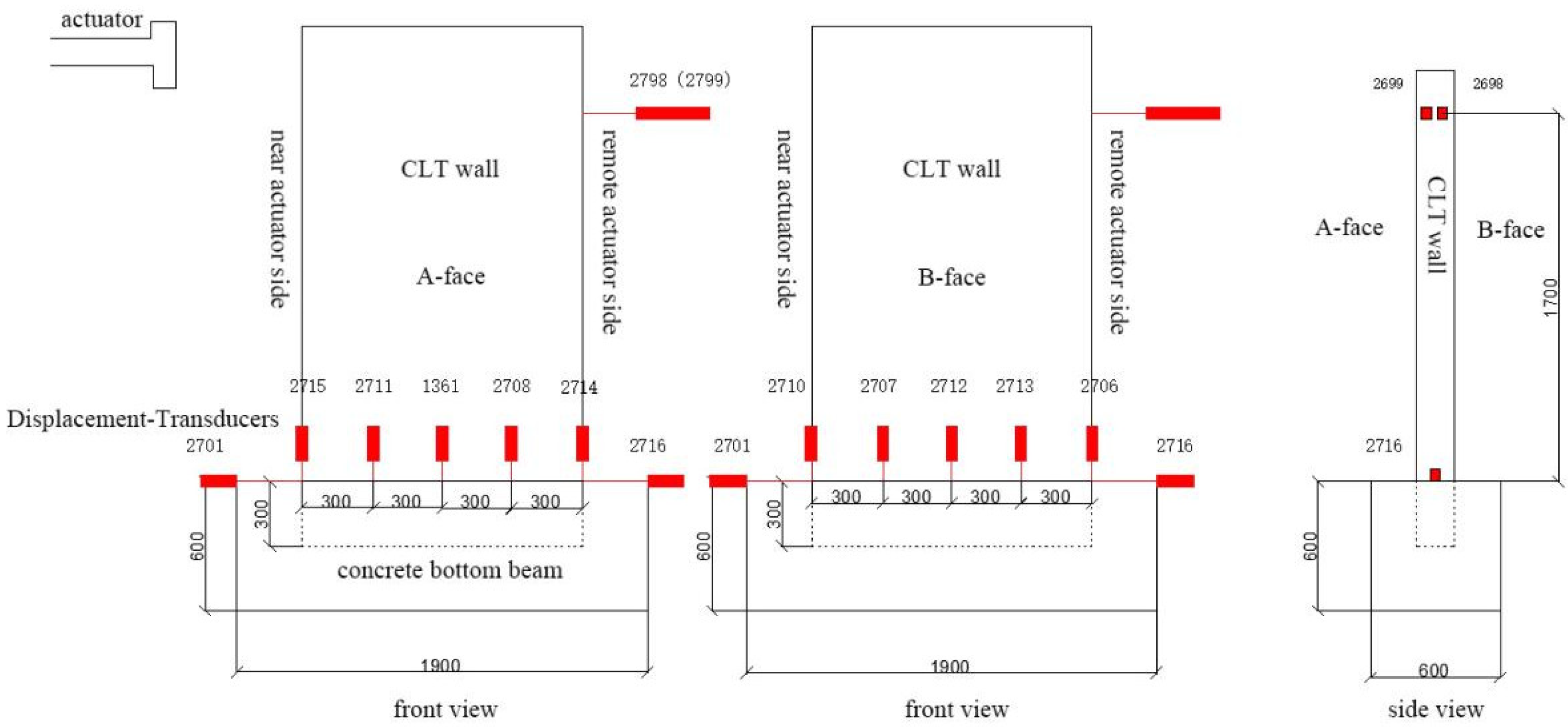
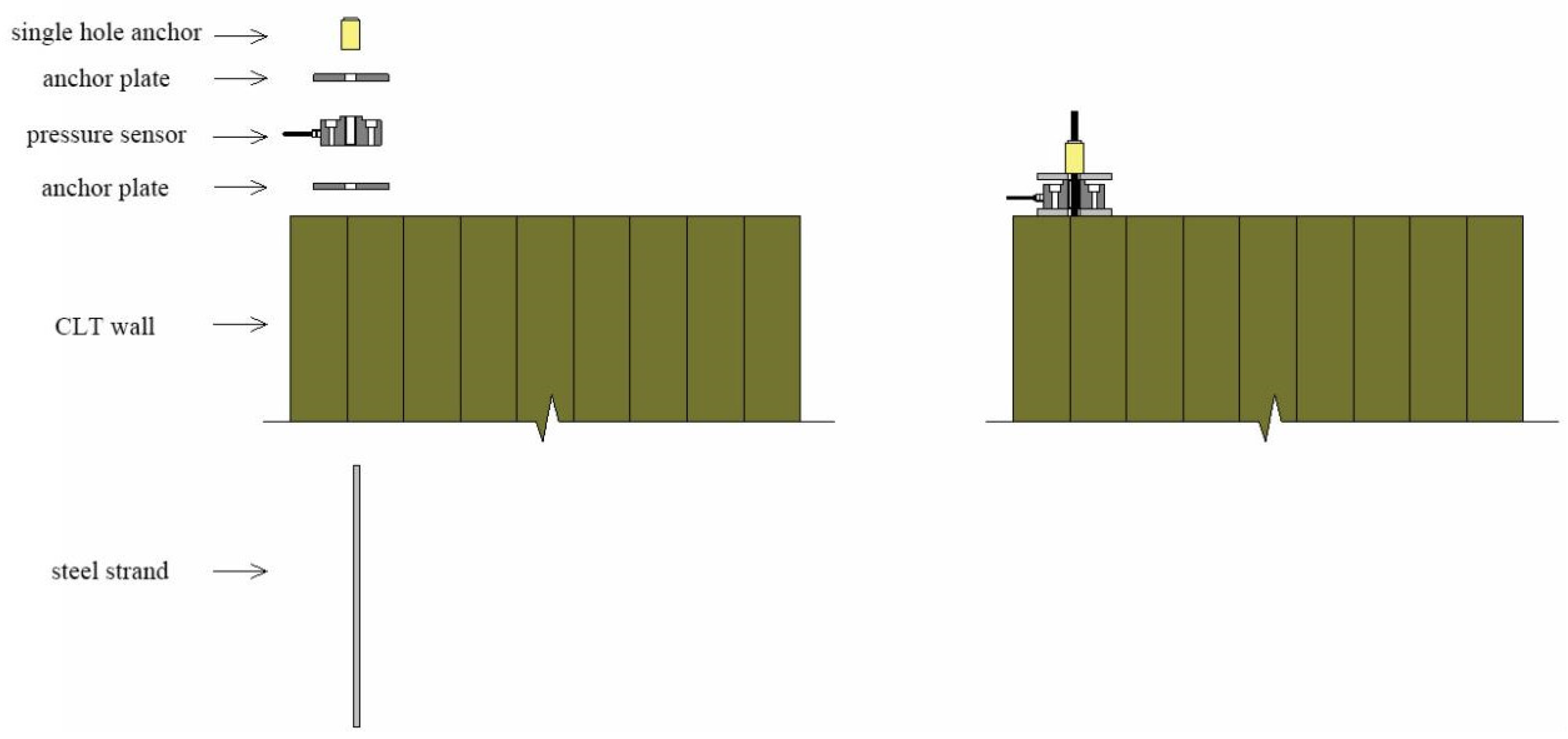

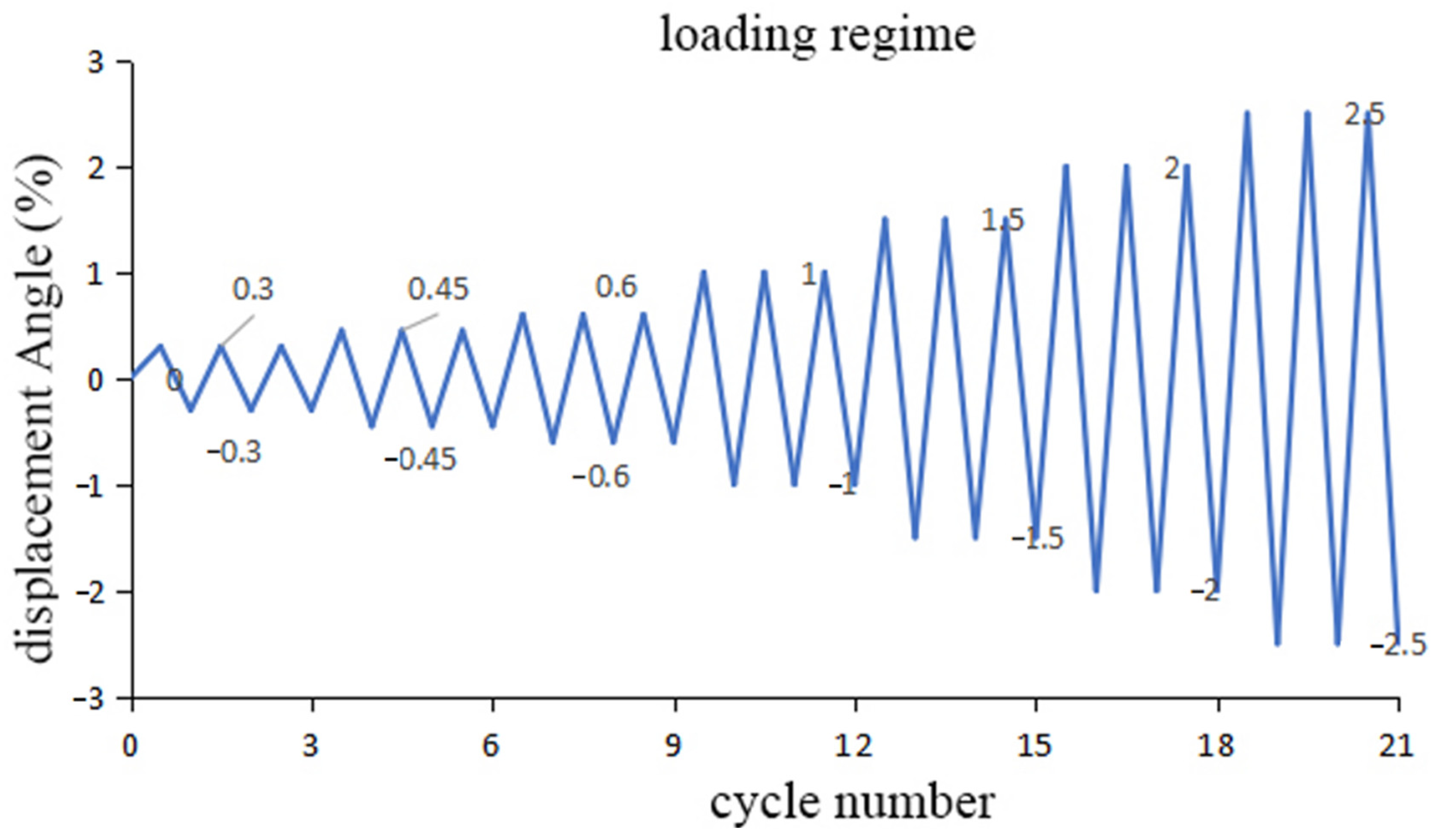
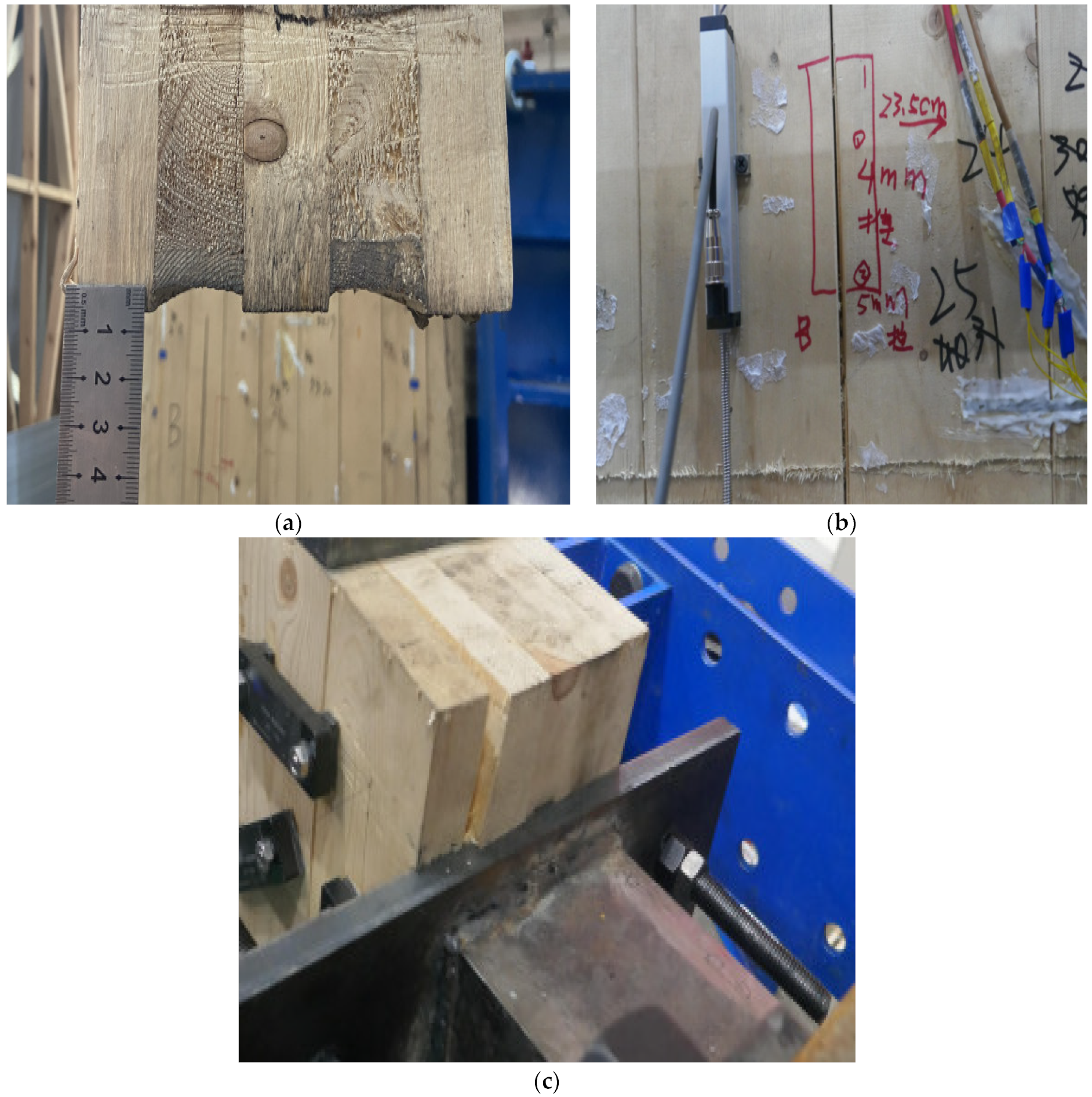
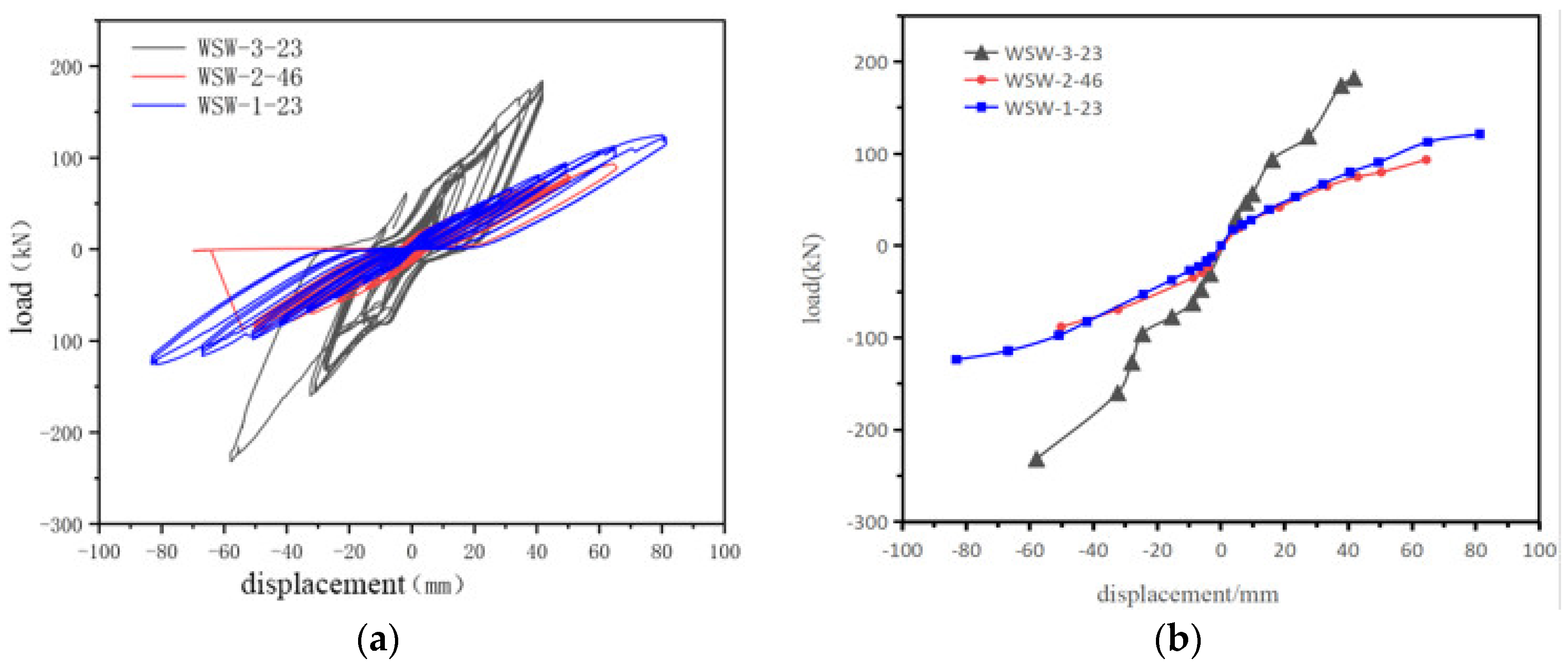
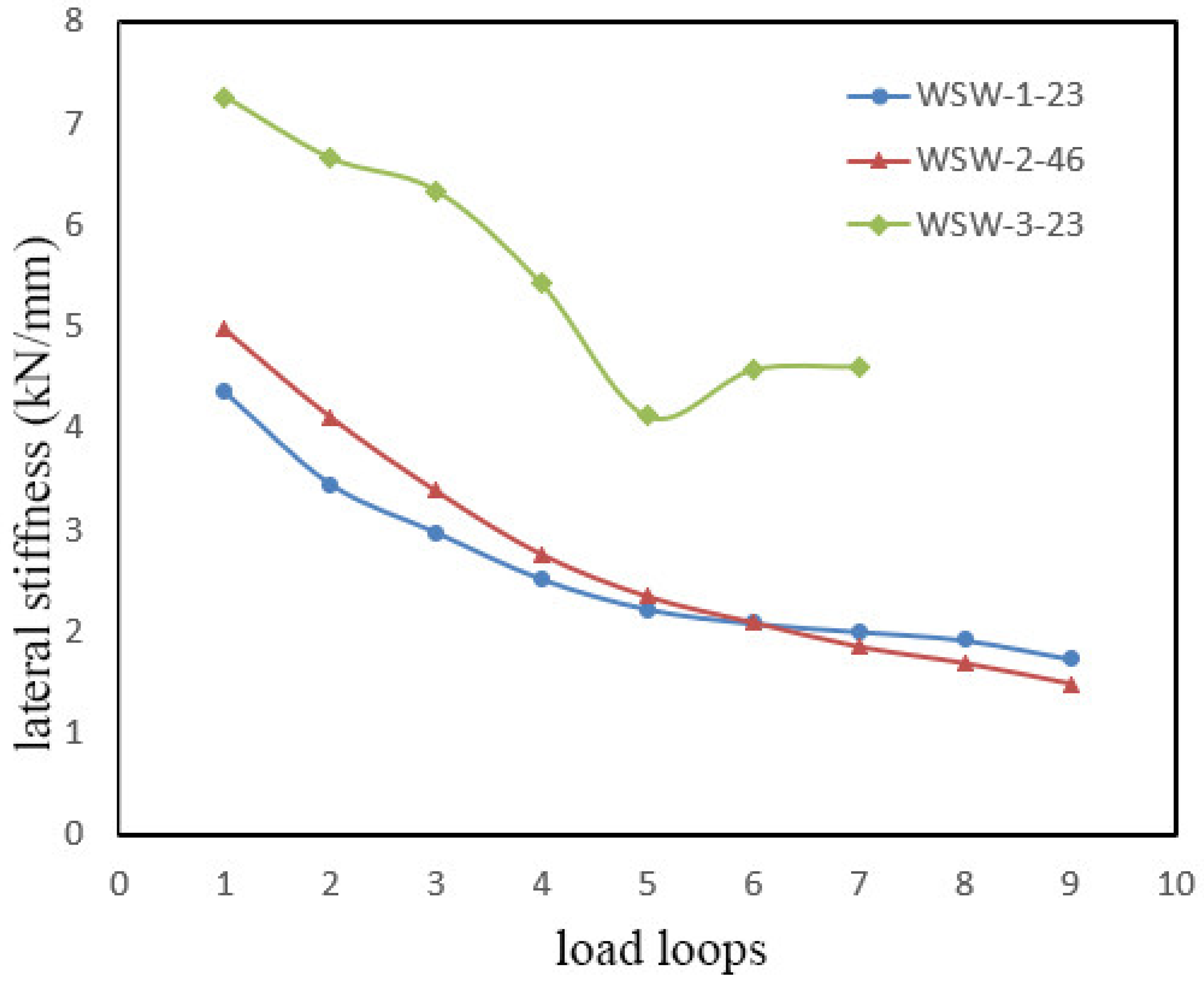
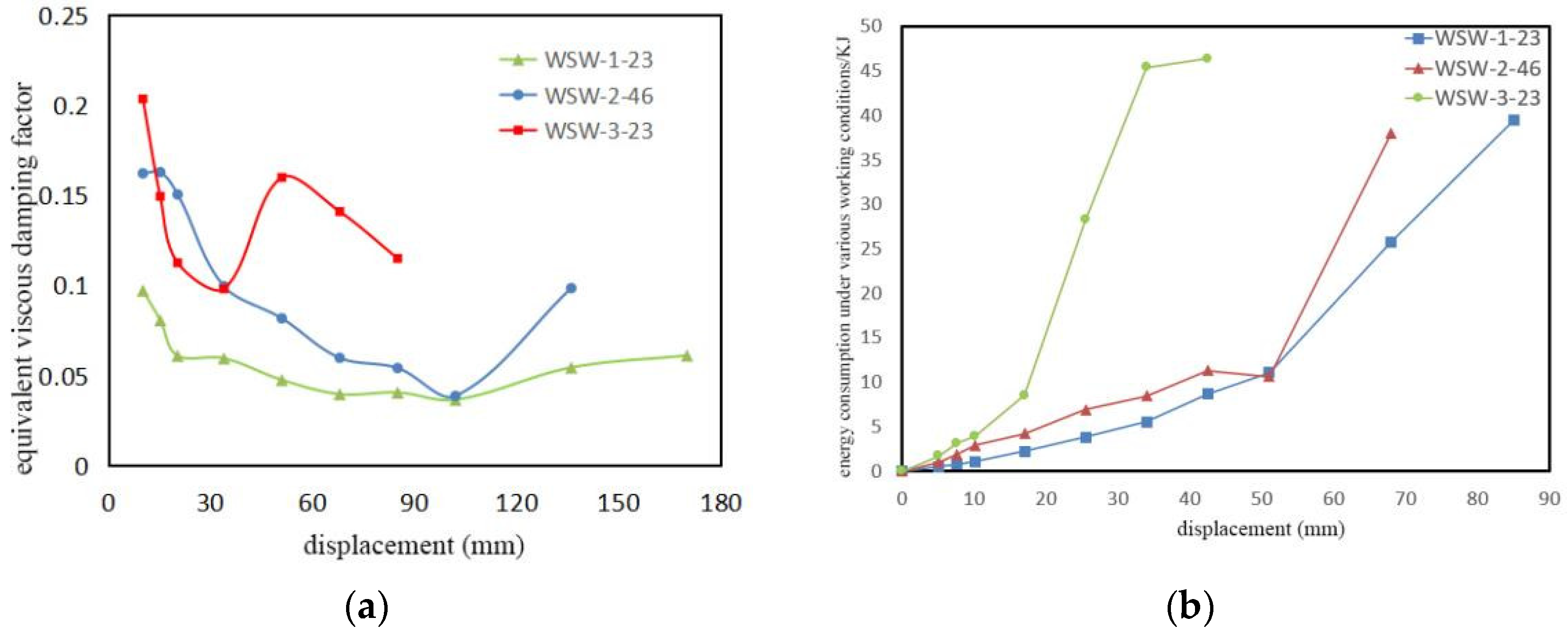
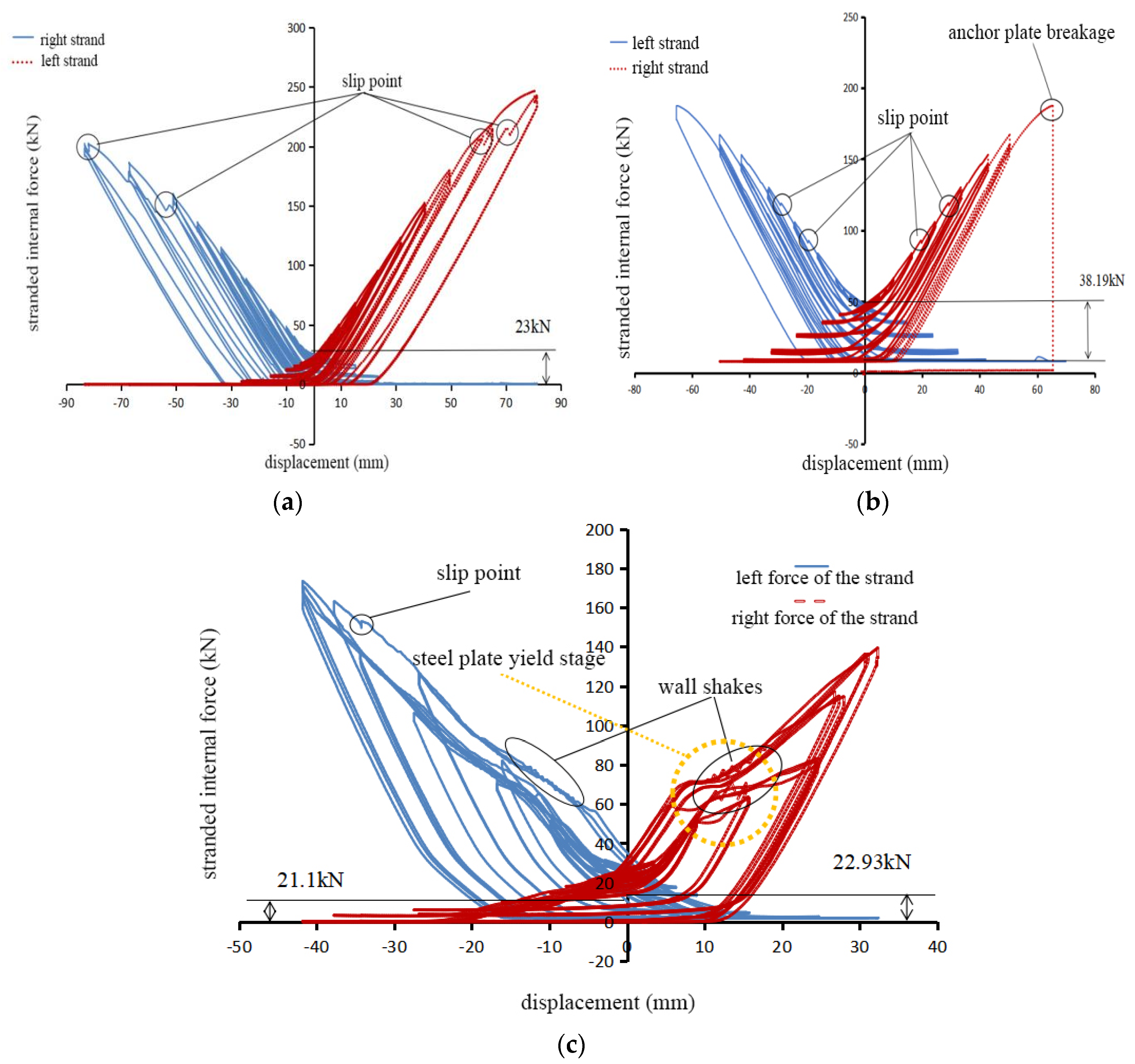
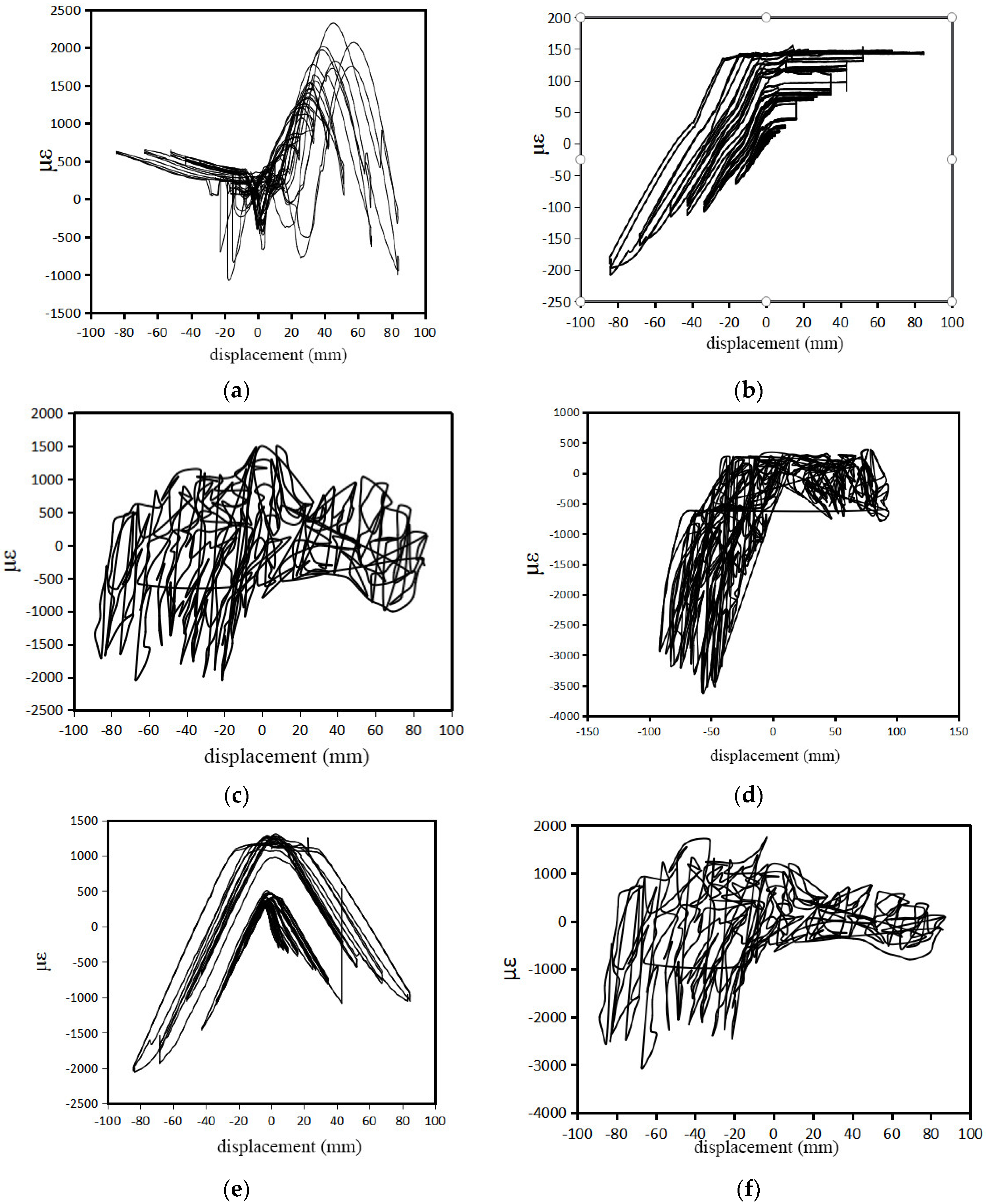
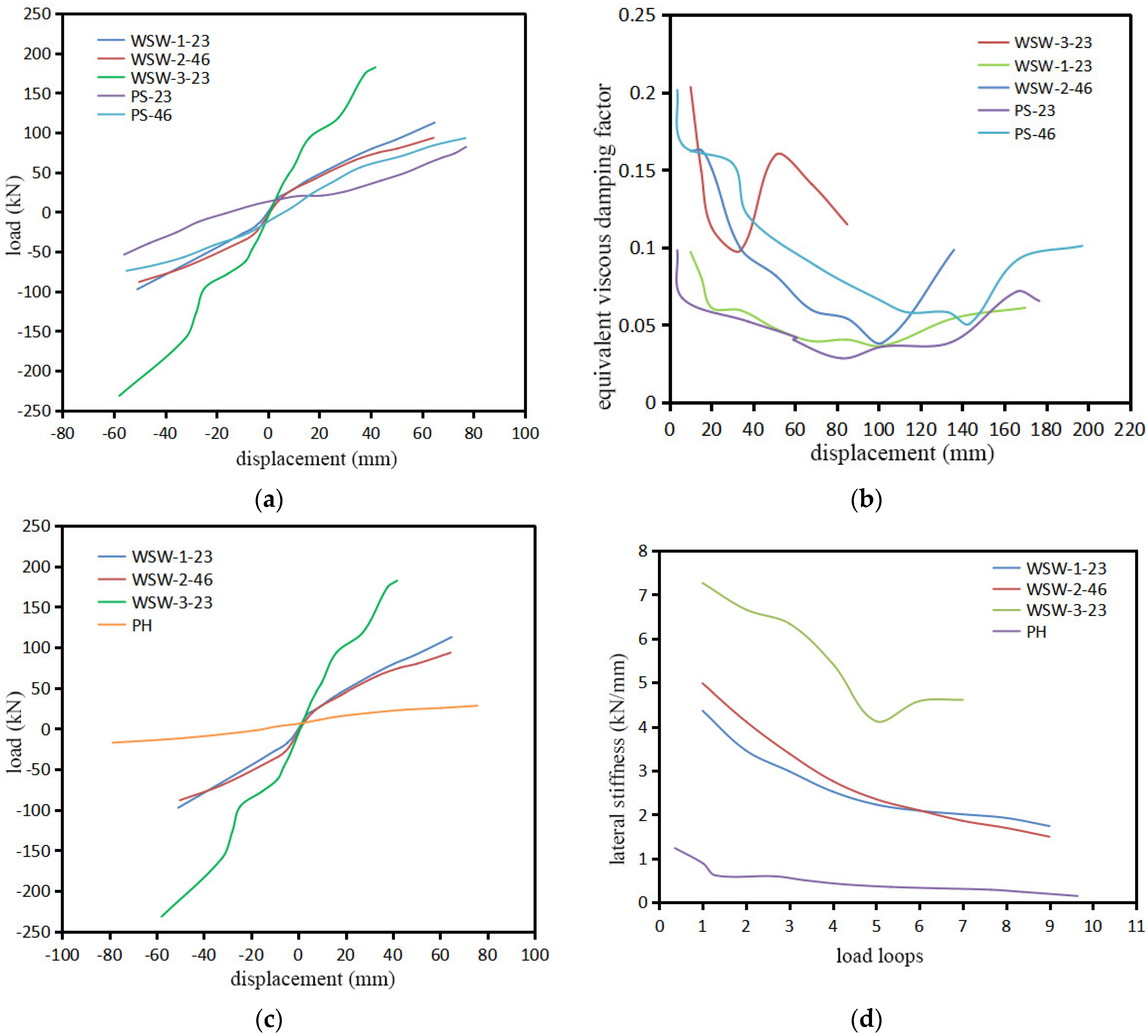
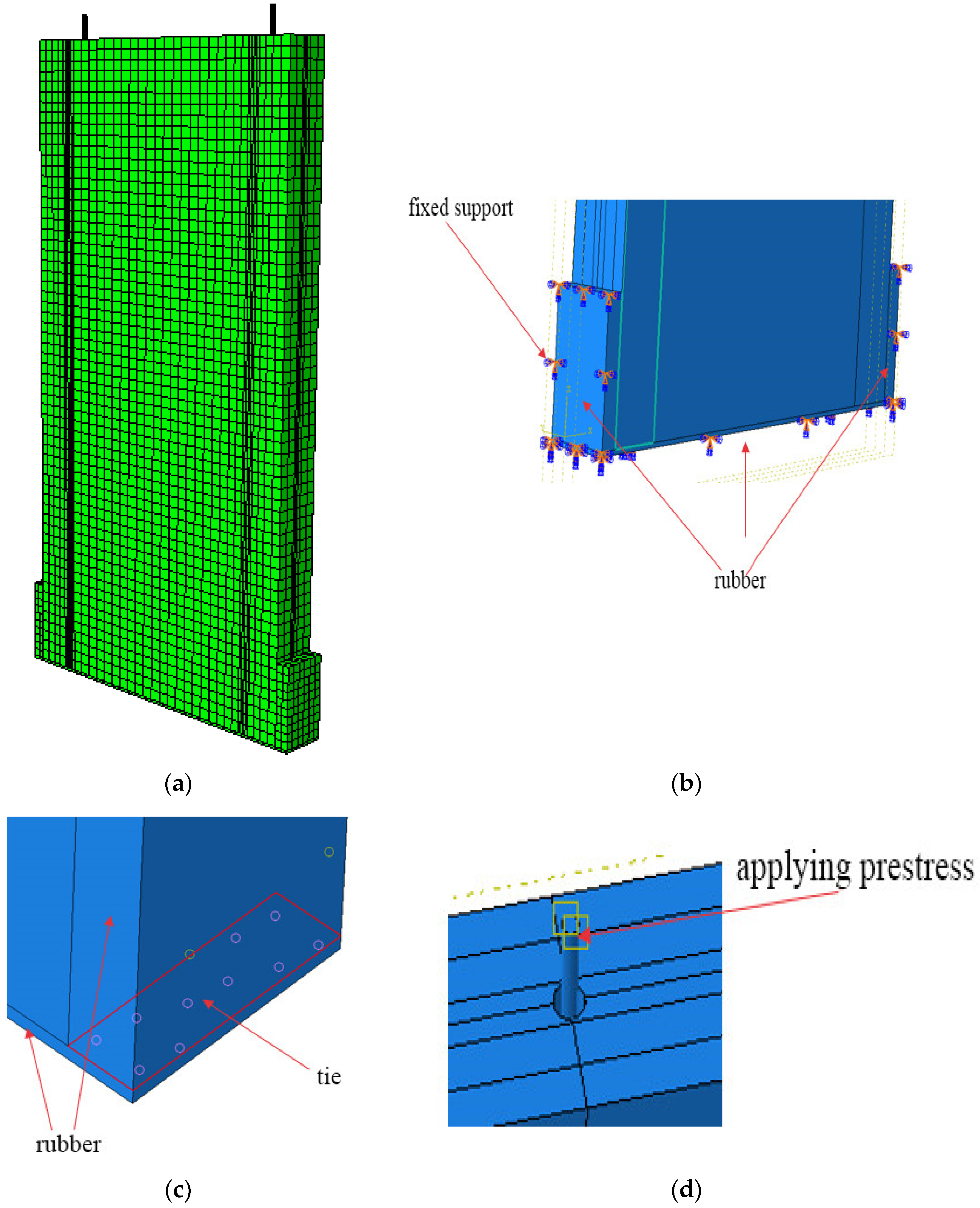
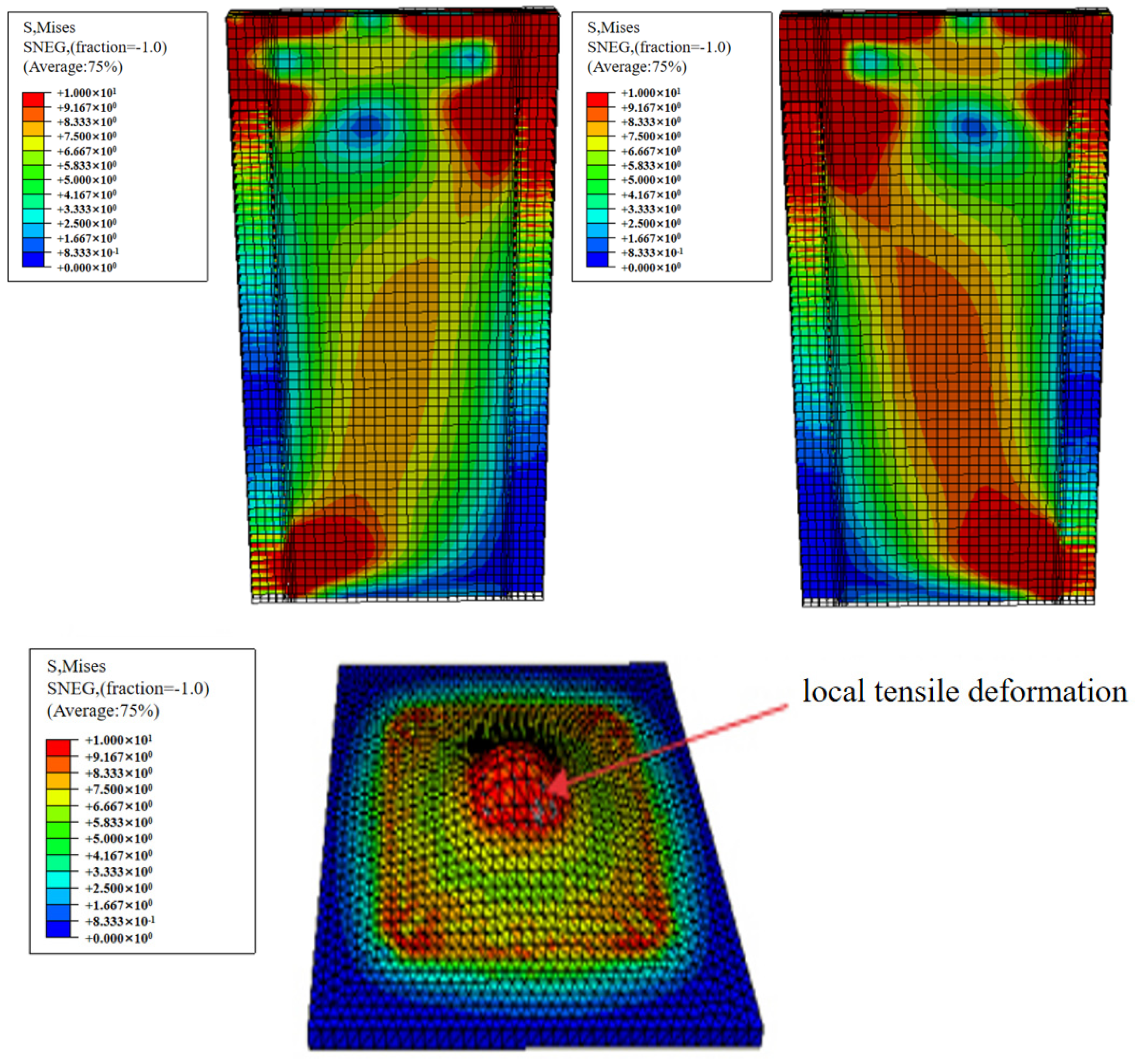


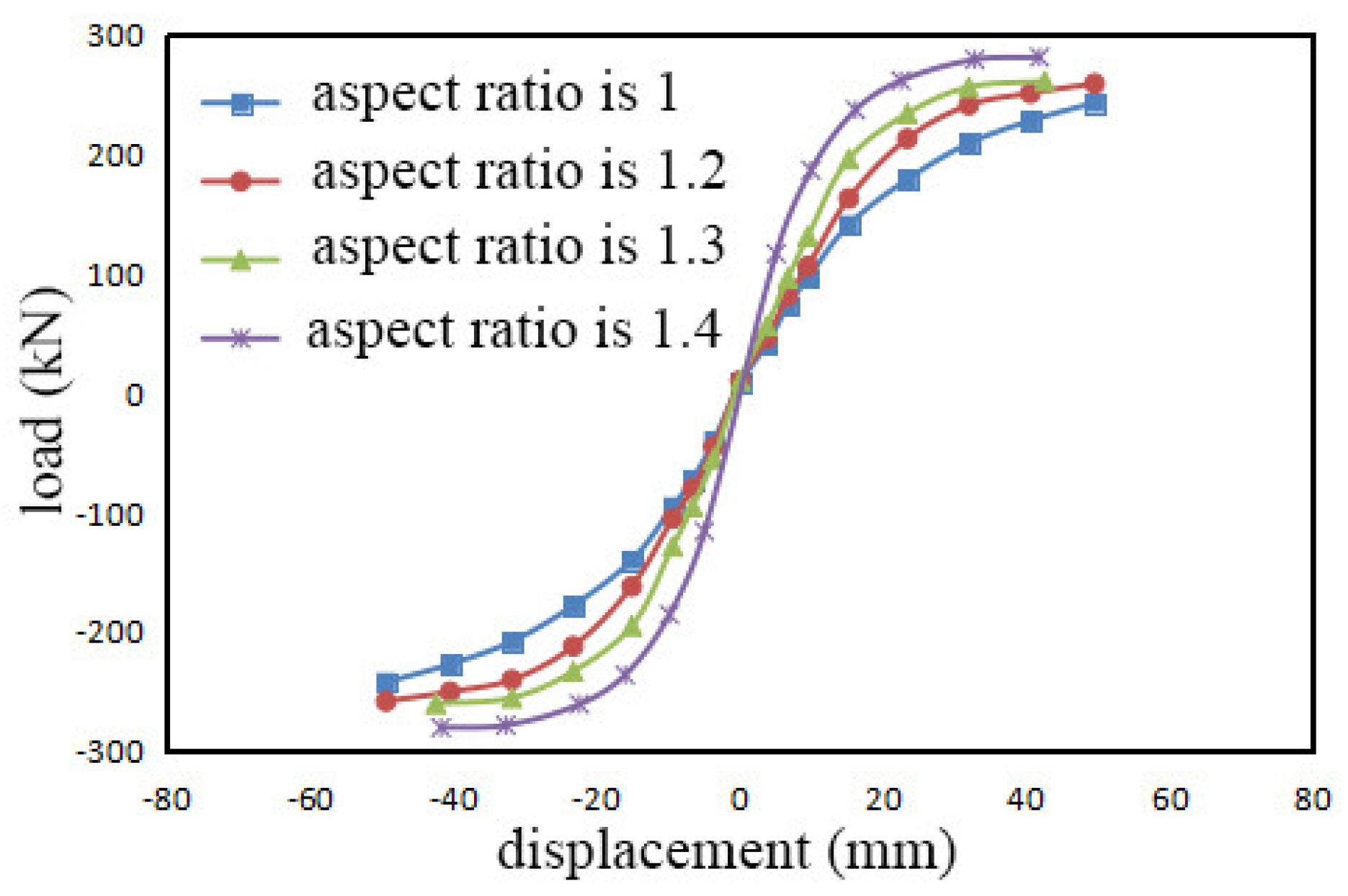
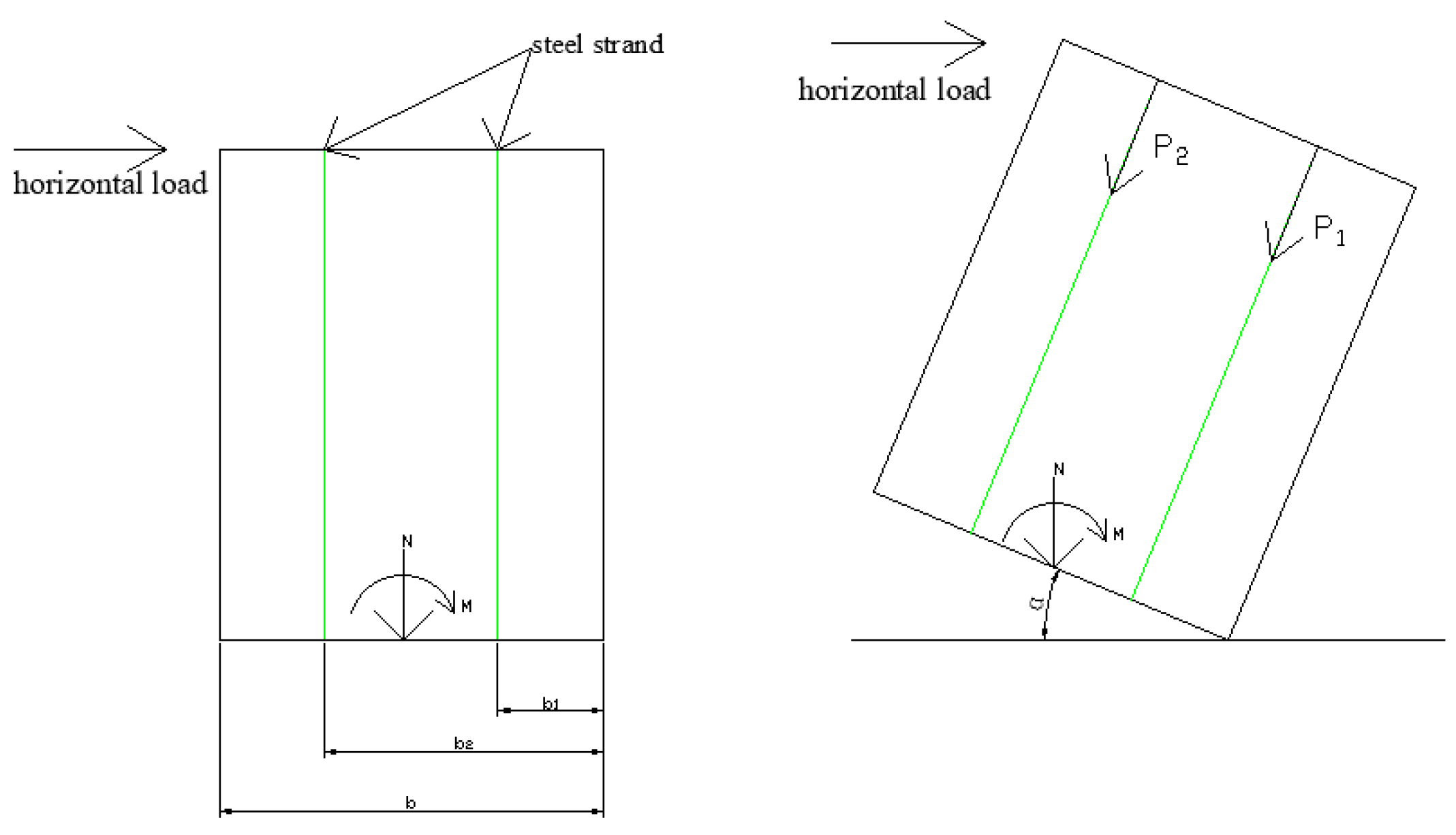
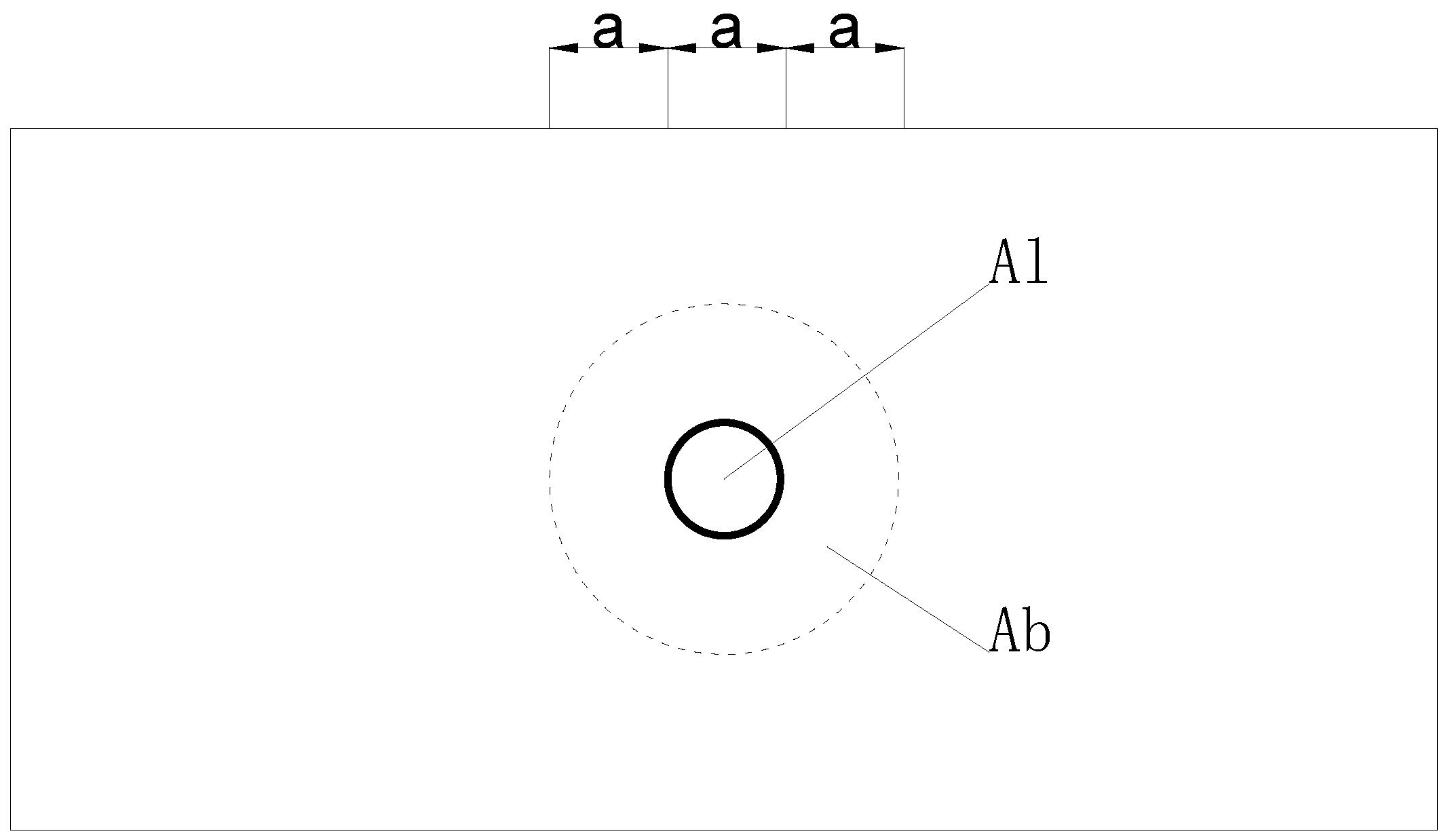
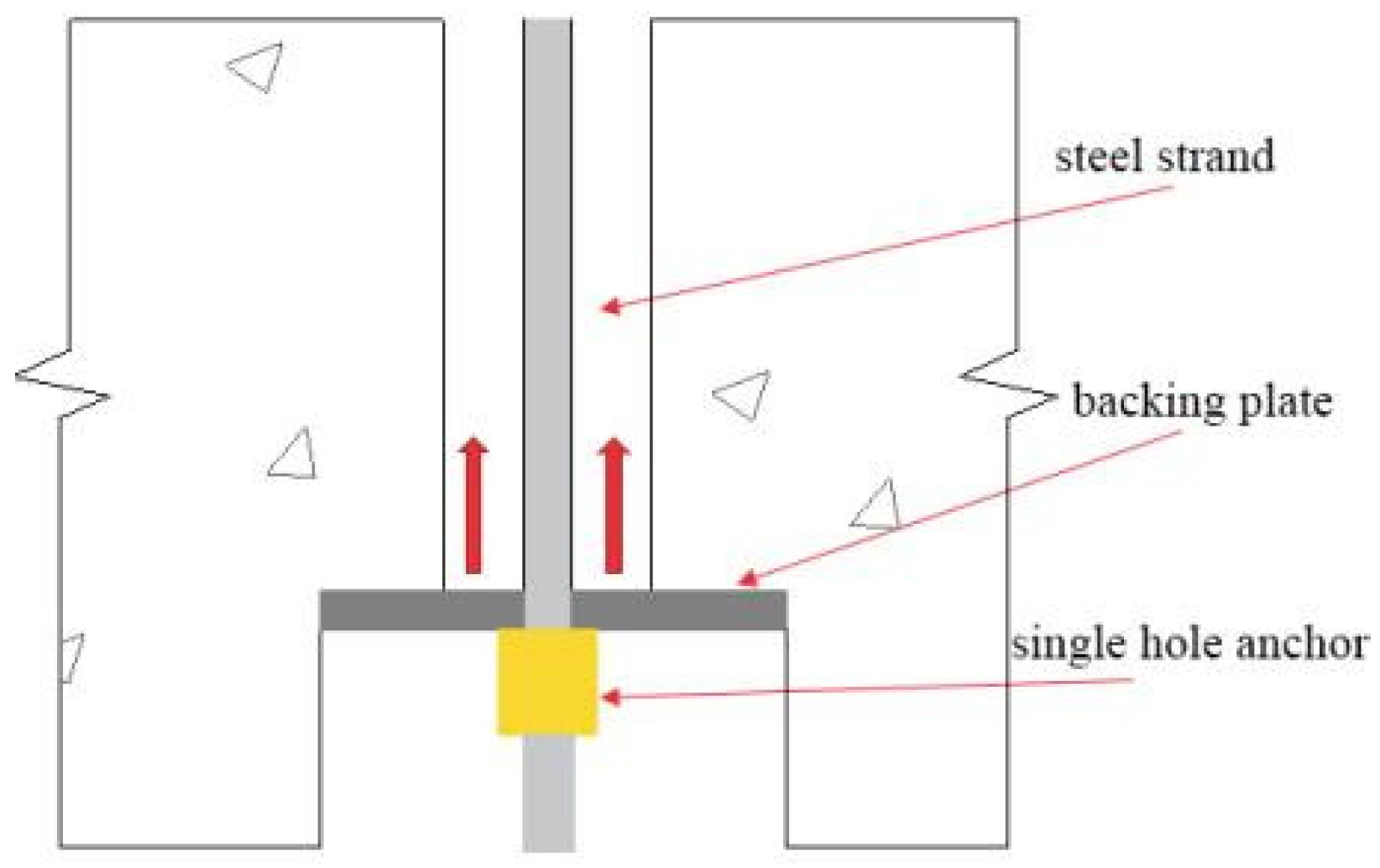
| Sample ID | Dimensions | Mass (g) | Density (kg/m3) | Average Density (kg/m3) | ||
|---|---|---|---|---|---|---|
| l | b | t | ||||
| 1 | 17.2 | 7.9 | 7.8 | 477.50 | 450.530 | 445.36 |
| 2 | 17.0 | 8.0 | 7.9 | 450.60 | 419.397 | |
| 3 | 17.0 | 7.9 | 7.8 | 468.82 | 447.511 | |
| 4 | 17.2 | 7.8 | 7.9 | 427.41 | 403.269 | |
| 5 | 17.8 | 8.0 | 7.9 | 445.51 | 396.023 | |
| 6 | 17.1 | 7.9 | 8.0 | 496.29 | 459.222 | |
| 7 | 17.2 | 7.9 | 7.8 | 474.02 | 447.246 | |
| 8 | 17.3 | 8.0 | 7.8 | 466.27 | 431.923 | |
| 9 | 17.3 | 7.9 | 7.8 | 467.25 | 438.592 | |
| 10 | 17.0 | 7.8 | 8.0 | 510.20 | 480.958 | |
| 11 | 17.0 | 7.9 | 7.8 | 503.17 | 480.335 | |
| 12 | 17.2 | 7.9 | 7.9 | 448.09 | 417.429 | |
| 13 | 17.0 | 7.9 | 7.9 | 509.32 | 480.051 | |
| 14 | 17.2 | 7.9 | 7.9 | 453.47 | 417.429 | |
| 15 | 17.1 | 8 | 7.9 | 484.25 | 480.051 | |
| 16 | 17.1 | 7.9 | 7.8 | 512.53 | 422.441 | |
| 17 | 17.3 | 7.9 | 7.9 | 446.02 | 448.081 | |
| 18 | 17.0 | 8.0 | 7.9 | 514.11 | 480.282 | |
| 19 | 17.2 | 7.8 | 7.9 | 489.98 | 413.099 | |
| 20 | 17.2 | 7.9 | 7.8 | 479.17 | 446.382 | |
| 21 | 17.2 | 7.8 | 7.9 | 455.18 | 429.470 | |
| 22 | 17.2 | 7.8 | 7.9 | 458.56 | 438.206 | |
| 23 | 17.1 | 7.9 | 7.8 | 490.95 | 460.031 | |
| 24 | 17.3 | 7.8 | 7.9 | 487.52 | 457.325 | |
| Sample ID | Dimensions (mm) | Number of Layers | Thickness of Each Layer (mm) | Diameter of Steel Strand (mm) | Initial Prestressing Forces (kN) |
|---|---|---|---|---|---|
| WSW-1-23 | 2400 × 1200 × 175 | 5 | 35 | 15.2 | 23 |
| WSW-2-46 | 2400 × 1200 × 175 | 5 | 35 | 15.2 | 46 |
| WSW-3-23 | 2400 × 2400 × 175 | 5 | 35 | 15.2 | 23 |
| Specimen | Location | Dimension (mm) | Hardness | Elastic Modulus (N/cm2) | Shear Modulus (N/cm2) | Correction Factor |
|---|---|---|---|---|---|---|
| WSW-1-23 | Bottom | 1300 × 175 × 10 | 60 | 445 | 106 | 0.57 |
| WSW-2-23 | Side | 50 × 175 × 300 | ||||
| WSW-3-23 | Bottom | 1300 × 175 × 10 | ||||
| Side | 50 × 175 × 300 |
| Sample ID | Dimensions (mm) | Materials | Drift Angle (%) | Bottom Beam | Initial Prestressing Forces (kN) | Maximum Load-Carrying Capacity (kN) |
|---|---|---|---|---|---|---|
| PS | 1200 × 2200 × 175 | Spruce–Pine–Fir | 2.5 | Steel | 23/46 | 52.5/60.8 |
| PH | 1200 × 2200 × 175 | 3 | Steel | N/A | 25.2 | |
| PQ | 1200 × 2400 × 175 | 2.5 | Reinforced concrete | 23/46 | 73.4/81.3 |
| EL | ER | ET | GLR | GLT | GRT | γLR | γLT | γRT |
|---|---|---|---|---|---|---|---|---|
| 17,930 | 1520 | 1130 | 1345 | 1075 | 322 | 0.43 | 0.37 | 0.63 |
| Sample ID | Dimensions (mm) | Number of Steel Strands | Strength Verification Values | Errors (%) | |
|---|---|---|---|---|---|
| Theoretical values | WSW-1-23 | 1200 × 2400 × 175 | 2 | 0.194 | - |
| WSW-2-46 | 1200 × 2400 × 175 | 2 | 0.189 | - | |
| WSW-3-23 | 2400 × 2400 × 175 | 2 | 0.203 | - | |
| WSW-1-0 | 1200 × 2400 × 175 | 2 | 0.04 | - | |
| WSW-1-70 | 1200 × 2400 × 175 | 2 | 0.197 | - | |
| WSW-1-90 | 1200 × 2400 × 175 | 2 | 0.201 | - | |
| Aspect ratio = 1.2 | 2880 × 2400 × 175 | 2 | 0.217 | - | |
| Aspect ratio = 1.3 | 3120 × 2400 × 175 | 2 | 0.221 | - | |
| Aspect ratio = 1.4 | 3360 × 2400 × 175 | 2 | 0.226 | - | |
| Experimental values | WSW-1-23 | 1200 × 2400 × 175 | 2 | 0.179 | 7.5 |
| WSW-2-46 | 1200 × 2400 × 175 | 2 | 0.143 | 23 | |
| WSW-3-23 | 2400 × 2400 × 175 | 2 | 0.186 | 8.3 | |
| Numerical simulation | WSW-1-23 | 1200 × 2400 × 175 | 2 | 0.183 | 5.6 |
| WSW-2-46 | 1200 × 2400 × 175 | 2 | 0.179 | 5.2 | |
| WSW-3-23 | 2400 × 2400 × 175 | 2 | 0.193 | 4.8 |
| Sample ID | (kN) | (kN) |
|---|---|---|
| WSW-1-23 | 295.8 | 2872.5 |
| WSW-2-46 | 112.8 | |
| WSW-3-23 | 321.6 |
| Sample ID | Thickness of Anchor Plate (mm) | Maximum Calculation Thickness (mm) | Anchor Plate Thickness Corresponding to Drift Angle of 2.5% (mm) |
|---|---|---|---|
| WSW-1-23 | 18 | 13.57 | 10.35 |
| WSW-2-46 | 12 | 10.7 | |
| WSW-3-23 | 18 | 11.52 |
| Sample ID | Thickness of Anchor Plate (mm) | (MPa) | Stress Corresponding to Drift Angle of 2.5% (mm) | Maximum Calculated Stress (MPa) |
|---|---|---|---|---|
| WSW-1-23 | 18 | 188 | 31.42 | 93.2 |
| WSW-2-46 | 12 | 78.213 | 201.5 | |
| WSW-3-23 | 18 | 88 | 93.2 |
Disclaimer/Publisher’s Note: The statements, opinions and data contained in all publications are solely those of the individual author(s) and contributor(s) and not of MDPI and/or the editor(s). MDPI and/or the editor(s) disclaim responsibility for any injury to people or property resulting from any ideas, methods, instructions or products referred to in the content. |
© 2024 by the authors. Licensee MDPI, Basel, Switzerland. This article is an open access article distributed under the terms and conditions of the Creative Commons Attribution (CC BY) license (https://creativecommons.org/licenses/by/4.0/).
Share and Cite
Xu, Y.; Huang, X.; Zhang, Y.; Qu, Y.; Fan, Y.; Yang, G. Research on Lateral Resistance Performance of Prestressed Cross-Laminated Timber–Concrete Composite Structures under Reciprocating Loads. Materials 2024, 17, 2485. https://doi.org/10.3390/ma17112485
Xu Y, Huang X, Zhang Y, Qu Y, Fan Y, Yang G. Research on Lateral Resistance Performance of Prestressed Cross-Laminated Timber–Concrete Composite Structures under Reciprocating Loads. Materials. 2024; 17(11):2485. https://doi.org/10.3390/ma17112485
Chicago/Turabian StyleXu, Yong, Xin Huang, Yingda Zhang, Yusen Qu, Yujie Fan, and Guoqin Yang. 2024. "Research on Lateral Resistance Performance of Prestressed Cross-Laminated Timber–Concrete Composite Structures under Reciprocating Loads" Materials 17, no. 11: 2485. https://doi.org/10.3390/ma17112485
APA StyleXu, Y., Huang, X., Zhang, Y., Qu, Y., Fan, Y., & Yang, G. (2024). Research on Lateral Resistance Performance of Prestressed Cross-Laminated Timber–Concrete Composite Structures under Reciprocating Loads. Materials, 17(11), 2485. https://doi.org/10.3390/ma17112485






